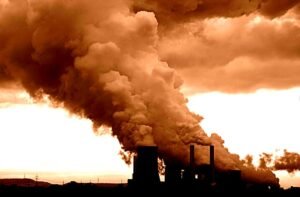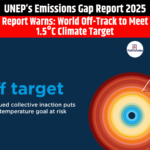India Emerges as a Leading Contributor to Global Greenhouse Emissions
|
General Studies Paper III: Environmental Pollution & Degradation, Growth & Development |
Why in News?
Recently, India has emerged as one of the leading contributors to global greenhouse gas emissions, according to the UNEP’s Emissions Gap Report 2025. The report highlights India’s growing industrial activities and energy demands, underlining an urgent call for stronger environmental policies and sustainable growth efforts.
Highlights of the Emissions Gap Report 2025
- Global Emission: The report states that G20 members, excluding the African Union, were responsible for about 77 percent of total global emissions in 2024, marking a 0.7 percent increase compared to the previous year.
- Global Temperature: Report indicates that the world is still not on track to meet the 1.5°C target set under the Paris Agreement. Even with new climate pledges, the planet is heading for a temperature increase of up to 2.8°C by 2100.
- Major Emitters: The report identifies India and China as the countries showing the highest absolute increases in greenhouse gas emissions, excluding land-use change and forestry. Among developing economies, Indonesia showed the fastest relative growth. The European Union emerged as the only major economy among the top six emitters — which include China, the United States, Russia, and India — to record a decline in total emissions during 2024.
- Projected Scenarios: Current trends suggest that average global temperatures could rise by 2.3°C to 2.5°C by the end of this century, even if all Nationally Determined Contributions (NDCs) are fully implemented.
- The multi-decadal average temperature rise will soon cross the 1.5°C mark, at least temporarily, within the early 2030s.
- The report stresses that an overshoot could increase dependence on carbon dioxide removal (CDR) technologies, which are still uncertain and costly.
- For instance, reversing each 0.1°C overshoot would require removing and permanently storing emissions equal to five years of current global CO₂ output.
- Recommendations: It recommends stringent near-term policies to bring down global emissions before 2030.
- The world must reduce total greenhouse gas emissions by at least 43% from 2019 levels by 2030 to keep the 1.5°C target alive.
- UNEP suggests increasing investment in renewable energy, energy efficiency, reforestation, and low-carbon technologies.
- It also urges countries to phase out coal and fossil fuels while supporting developing economies through climate finance and technology transfer.
India’s Rising Role in Global Greenhouse Gas Emissions
- India has become one of the leading contributors to global greenhouse gas (GHG) emissions according to the UNEP Emissions Gap Report 2025.
- The report shows that India’s emissions have seen the highest absolute increase among major economies, excluding land-use and forestry activities.
- India now ranks among the top three emitters of greenhouse gases, alongside China and the United States.
- The report places India as a central figure in global climate discussions because its emission trends strongly influence the world’s ability to meet the Paris Agreement’s targets.
- India’s GHG emissions mainly come from four key sectors: energy production, transportation, industry, and agriculture.
- The energy sector contributes the most, as India continues to rely heavily on coal-based power plants, which generate more than 70% of the nation’s electricity.
- The transport sector adds to emissions through rapid motorization and rising fuel consumption.
- The industrial sector, including steel, cement, and manufacturing, has also expanded rapidly over the last decade, adding significantly to the total carbon footprint.
- Agriculture, particularly methane emissions from livestock and rice cultivation, remains another major contributor.
- As per government data for 2024, coal accounted for about 55% of India’s primary energy supply. The rapid increase in electricity demand due to urbanization and industrialization has led to higher coal consumption.
- The Central Electricity Authority (CEA) reported that coal-based power plants emitted approximately 1.3 billion tonnes of CO₂ equivalent in 2024. The slow transition is one of the main reasons for India’s high emission levels.
- India’s growing urban population is another key factor behind rising emissions. In 2024, over 36% of India’s population lived in urban areas, a figure expected to reach 40% by 2030.
- The transport sector contributed nearly 10% of India’s total CO₂ emissions in 2024, as per the Ministry of Environment, Forest and Climate Change (MoEFCC). The use of petrol and diesel vehicles continues to dominate, despite growing interest in electric mobility.
Impact of Rising Emissions in India
- Environmental Degradation: Rising emissions in India increase air pollution, temperature levels, and weather instability. The higher concentration of greenhouse gases traps more heat in the atmosphere and changes rainfall patterns. India experiences more frequent heatwaves, floods, and droughts due to this imbalance. These changes disturb ecosystems, reduce biodiversity, and damage forests and rivers.
- Air Quality Decline: Higher emissions reduce air quality and expose millions of people to toxic pollutants. Major cities like Delhi, Mumbai, and Kolkata often record Air Quality Index (AQI) levels far above safe limits. Polluted air causes respiratory problems, heart diseases, and premature deaths. According to the Global Burden of Disease Report 2024, poor air quality contributes to more than 2 million deaths annually in India.
- Economic Losses: Emissions-driven climate change reduces productivity in agriculture, industry, and labor sectors. Irregular monsoons and temperature rise reduce crop yields and increase pest attacks. Farmers face losses and unstable incomes. Industrial operations also suffer from energy disruptions and water scarcity. Rising emissions create a cycle of environmental and economic stress that slows national growth.
India’s Commitments Under International Climate Agreements
- Paris Agreement (2015): India joined the Paris Agreement on October 2, 2016. The Paris Agreement aims to limit global temperature rise to well below 2°C and pursue efforts to stay within 1.5°C above pre-industrial levels. India submitted its first NDCs in 2015, outlining targets for emission reduction, renewable energy growth, and forest carbon enhancement. These commitments formed the foundation of India’s international climate policy for the decade ahead.
- Updated NDC Targets (2022): In August 2022, India submitted its updated NDC to the United Nations Framework Convention on Climate Change (UNFCCC). India committed to reduce the emission intensity of its GDP by 45% by 2030, compared to 2005 levels. It also pledged to achieve about 50% of its total installed electric capacity from non-fossil fuel sources by 2030. The updated NDC also reinforced India’s commitment to climate resilience, energy security, and sustainable growth.
- Net-Zero by 2070: India has been an active participant in all major Conference of the Parties (COP) meetings under the UNFCCC. India announced its net-zero emissions target by 2070 at the COP26 summit in Glasgow in November 2021. India presented five key pledges known as Panchamrit. These included reaching 500 GW of non-fossil fuel energy capacity, meeting 50% of energy needs from renewables, reducing carbon emissions by 1 billion tonnes, cutting emission intensity of GDP by 45%, and achieving net-zero by 2070. These goals provide a roadmap for India’s energy transition.
Government Policies and Green Initiatives for Emission Reduction
- National Action Plan on Climate Change (NAPCC): The National Action Plan on Climate Change (NAPCC) was launched in 2008 by the Prime Minister’s Council on Climate Change. It provides a broad policy framework for India’s response to climate change. The NAPCC includes eight major missions focusing on solar energy, sustainable agriculture, energy efficiency, and water conservation. The plan encourages both central and state governments to adopt environment-friendly strategies across sectors.
- National Solar Mission (Jawaharlal Nehru National Solar Mission): The National Solar Mission, launched in January 2010, is one of India’s most successful renewable energy programs. It aims to promote the use of solar power to reduce dependence on fossil fuels. The initial target was to achieve 20 GW of solar capacity by 2022, but the goal was later revised to 100 GW due to rapid progress. The mission encourages solar parks, rooftop installations, and off-grid solutions.
- National Wind Energy Mission: This Mission focuses on expanding wind energy generation to meet renewable energy targets. India is one of the top four wind energy producers in the world. The mission aims to reach a capacity of 140 GW of wind power by 2030. The mission promotes new technology adoption, better grid connectivity, and offshore wind projects.
- National Green Hydrogen Mission: The Mission was launched on August 15, 2021, to make India a global hub for green hydrogen production. The mission supports the production of hydrogen using renewable energy sources, particularly solar and wind power. The government targets the production of 5 million tonnes of green hydrogen annually by 2030. This initiative aims to decarbonize industries such as steel, cement, and fertilizers.
- Ujjwala Yojana: The Pradhan Mantri Ujjwala Yojana (PMUY) was launched in May 2016 by the Ministry of Petroleum and Natural Gas. It provides LPG connections to women from low-income households to replace traditional cooking fuels like wood, coal, and dung. The scheme has distributed over 9.6 crore LPG connections by 2025. It has helped reduce carbon emissions, improved public health, and empowered rural women.
- Faster Adoption and Manufacturing of Electric Vehicles (FAME) Scheme: The FAME India Scheme was introduced in 2015 under the National Electric Mobility Mission Plan (NEMMP). Its goal is to promote electric vehicles (EVs) for public and private transport. The second phase, FAME-II, launched in 2019, focuses on supporting electric buses, two-wheelers, and charging infrastructure. It has reduced fuel consumption and urban air pollution in major cities.
- National Bioenergy Mission: The National Bioenergy Mission, launched in 2014, promotes the use of biomass and waste-to-energy technologies to generate power. It aims to utilize agricultural residues, animal waste, and urban solid waste for clean energy production. The mission supports biogas plants, biomass gasifiers, and cogeneration projects.
- Green India Mission: The National Mission for a Green India, started in 2014, aims to increase forest and tree cover to absorb carbon dioxide. The mission targets the restoration of 5 million hectares of degraded forest land and improvement of ecosystem services. According to the India State of Forest Report 2023, India’s total forest and tree cover has reached 24.6% of its geographical area. It strengthens India’s commitment to environmental restoration and climate resilience.
The Road Ahead
India stands at a crucial stage where it must balance rapid development with environmental sustainability. India should pursue low-carbon growth that supports both economic progress and ecological protection. India can achieve this by expanding renewable energy capacity, particularly in solar, wind, and green hydrogen sectors, to reduce dependence on coal and fossil fuels. Strengthening public transport, electric mobility, and energy efficiency in industries and households will further cut emissions. Encouraging climate-smart agriculture and protecting forests can enhance natural carbon absorption. At the same time, community awareness and innovation must play a central role.
|
Also Read: India’s First Off-Grid Green Hydrogen Plant |









